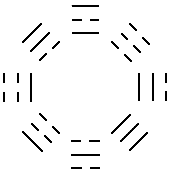2. LEARN BASIC FENG SHUI PRINCIPLES
Before you start moving around large pieces of furniture to maximize your ch'i, you need to understand the principles lying behind the guidelines. After all, what good is it to rearrange your living space if you don't understand the theory behind it?
Yin and yang
Yin and Yang are not the names of twin pandas. Well, actually, they probably are, but that's not the Yin and Yang we're talking about. Yin (black) and yang (white) are the harmonizing factors of the universe: opposing energies like day and night. Here's a picture:

Oooh… pretty. Yin and yang are totally dependent upon one another and one does not exist without the other. In fact, there is always a little bit of yang within yin (the white spot on the yin side) and vice versa.
Yin and yang are typically portrayed inside a Taichi circle, which symbolizes completeness. Lifeforce energy (that is, ch'i) created the oppositional duality of yin and yang - neither is good or evil - they just exist that way. Below are the characteristics associated with yin and yang.
YinYang BlackNight
Female
Receptive
Yielding
Negative
Supports, nurtures, and sustains
Shady, northern side of a hill
Valleys, rivers, streams White
Day
Male
Active
Dominating
Positive
Full of power and energy
Sunny, southern side of a hill
Hills, mountains, raised topography
In feng shui, the goal is to achieve a balance of yin and yang. For example, if a backyard is too hilly (too much Mr. Yang) one would want to introduce a water feature or some plants to break up the landscape (introduce Ms. Yin).
The eight trigrams
The eight trigrams of the "I Ching" are the secret of life. Oh… so THAT'S the secret! And we thought the secret to life was the respiratory system! The I Ching, China's oldest and most influential book, describes nature (and everything else in the universe) as moving and changing. Here's a picture of the eight trigrams:

Each series of three lines represents a different "house." We'll get back to all these little lines later. For now, just know that they're important.
The five elements
Ch'i energy can be manifested in five forms - the five elements of fire, earth, wood, water, or metal. (Contrary to popular belief, Milla Jovovich is not the fifth element.) The Chinese believe these elements affect everything we do. For example, in our horoscopes we have some of each element; however, how much we have of each element determines our personality and success (we'll tell you more about how to find out your personal elements later on in Step 4). Characteristics of the elements are listed below:
WoodFireEarthMetalWater- Creative
- Innovative
- Pliant and bending,
or - Strong and unyielding
- Sociable and community minded
- Color: green
- Direction: east & northeast
- Life cycle: birth & early childhood
- Energy
- Enthusiasm
- Can be dangerous
- Warms and cheers, but can burn and destroy
- Natural leader
- Color: red
- Direction: south
- Life cycle: late childhood before puberty
- Stable
- Real estate and legacies
- Patient, just, honest, and methodical
- Can be smothering and demanding
- Color: yellow
- Direction: center, southwest, & northeast
- Life cycle: adolescence
- Harvest
- Business
- Success (financial)
- Can symbolize the sword and be destructive and violent
- Color: white
- Direction: west & northwest
- Life cycle: adulthood
- Travel
- Communication
- Literature, arts & media
- Gentle (soft rain) or Violent (hurricane)
- Nourishes living things, but can wear away rock
- Color: black
- Direction: north
- Life cycle: old age
These elements interact with each other in cycles. You need to know these cycles, because it affects how you're going to arrange your living quarters. But for now, just frolic in the theory.
- Cycle of production - GOOD
Fire produces earth (ash), earth creates metal, metal liquefies, water nurtures plants, and burning wood creates fire.
FIRE -> EARTH -> METAL -> WATER -> WOOD -> FIRE -> . . . and so on!
- Cycle of destruction - BAD
Fire melts metal, metal destroys wood, wood draws from earth, earth overpowers water, and water puts out fire.
FIRE destroys METAL destroys WOOD destroys EARTH
destroys WATER destroys FIRE . . . and so on!
- Cycle of reduction - NEUTRAL
This cycle corrects imbalances caused by the cycle of destruction. It's the reverse of production.
FIRE rebalances WOOD rebalances WATER rebalances METAL
rebalances EARTH rebalances FIRE . . . and so on!
So let's pretend that you are a WATER. Then it means that you should surround yourself with METALS (because it allows for production of your element), but you should keep away from EARTHS (because it destroys your element).

